修饰不可数和可数名词
- 格式:doc
- 大小:17.00 KB
- 文档页数:4
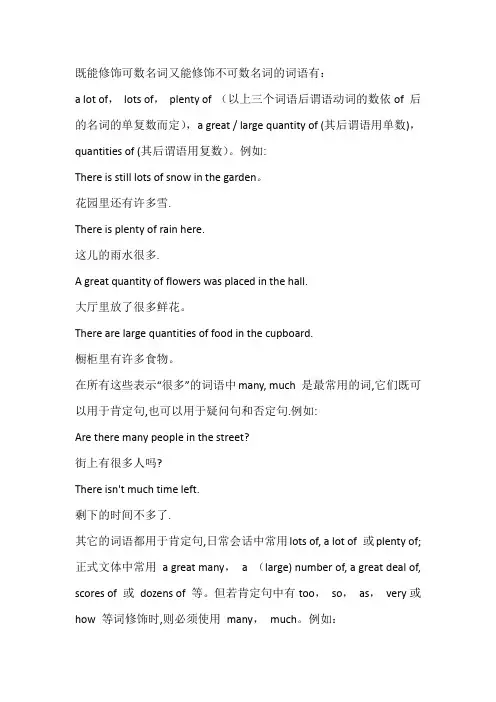
既能修饰可数名词又能修饰不可数名词的词语有:a lot of,lots of,plenty of (以上三个词语后谓语动词的数依of 后的名词的单复数而定),a great / large quantity of (其后谓语用单数),quantities of (其后谓语用复数)。
例如:There is still lots of snow in the garden。
花园里还有许多雪.There is plenty of rain here.这儿的雨水很多.A great quantity of flowers was placed in the hall.大厅里放了很多鲜花。
There are large quantities of food in the cupboard.橱柜里有许多食物。
在所有这些表示“很多”的词语中many, much 是最常用的词,它们既可以用于肯定句,也可以用于疑问句和否定句.例如:Are there many people in the street?街上有很多人吗?There isn't much time left.剩下的时间不多了.其它的词语都用于肯定句,日常会话中常用lots of, a lot of 或plenty of; 正式文体中常用a great many,a (large) number of, a great deal of, scores of 或dozens of 等。
但若肯定句中有too,so,as,very或how 等词修饰时,则必须使用many,much。
例如:The number of the people who lost their homes reached as many as 250,000。
无家可归的人数多达250,000人。
There is too much work to do。
要做的工作太多了.。
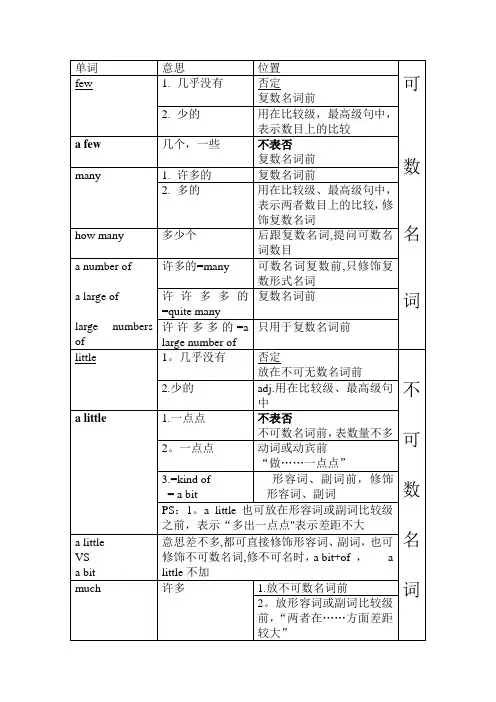
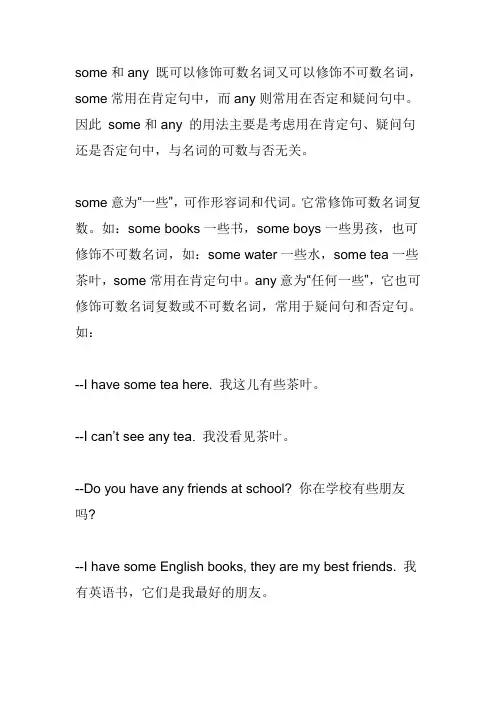
some和any 既可以修饰可数名词又可以修饰不可数名词,some常用在肯定句中,而any则常用在否定和疑问句中。
因此some和any 的用法主要是考虑用在肯定句、疑问句还是否定句中,与名词的可数与否无关。
some意为“一些”,可作形容词和代词。
它常修饰可数名词复数。
如:some books一些书,some boys一些男孩,也可修饰不可数名词,如:some water一些水,some tea一些茶叶,some常用在肯定句中。
any意为“任何一些”,它也可修饰可数名词复数或不可数名词,常用于疑问句和否定句。
如:--I have some tea here. 我这儿有些茶叶。
--I can’t see any tea. 我没看见茶叶。
--Do you have any friends at school? 你在学校有些朋友吗?--I have some English books, they are my best friends. 我有英语书,它们是我最好的朋友。
但在表示建议,反问,请求的疑问句中,或期望得到肯定回答时,多用some而不用any。
如:Would you like some coffee? 你要不要来点咖啡?What about some fruit juice? 来点水果汁如何?当any表示“任何”的意义,起强调作用时,它可以用在肯定句中;Any student can answer this question.任何学生都可以回答这个问题。
选题角度:辨析some和any的不同用法:some 常用在肯定句中,而any 则常用在否定和疑问句中。
在表示建议,反问,请求的疑问句中,或期望得到肯定回答时,多用some而不用any。
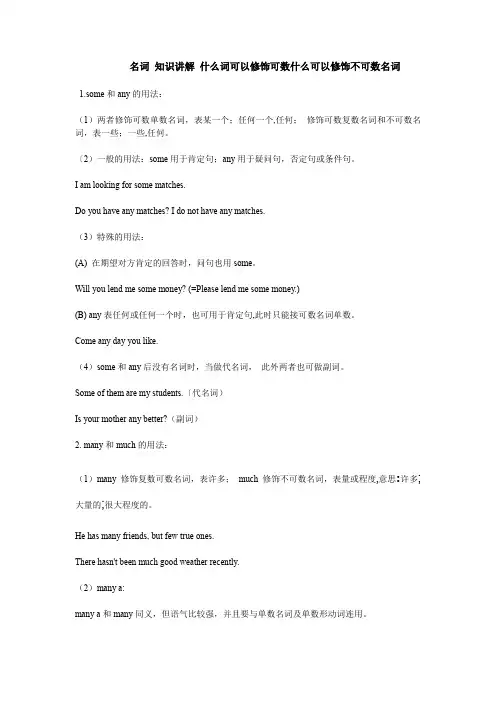
名词知识讲解什么词可以修饰可数什么可以修饰不可数名词1.some和any的用法:(1)两者修饰可数单数名词,表某一个;任何一个,任何;修饰可数复数名词和不可数名词,表一些;一些,任何。
〔2)一般的用法:some用于肯定句;any用于疑问句,否定句或条件句。
I am looking for some matches.Do you have any matches? I do not have any matches.(3)特殊的用法:(A) 在期望对方肯定的回答时,问句也用some。
Will you lend me some money? (=Please lend me some money.)(B) any表任何或任何一个时,也可用于肯定句,此时只能接可数名词单数。
Come any day you like.(4)some和any后没有名词时,当做代名词,此外两者也可做副词。
Some of them are my students.〔代名词)Is your mother any better?(副词)2. many和much的用法:(1)many修饰复数可数名词,表许多;much修饰不可数名词,表量或程度,意思:许多;大量的;很大程度的。
He has many friends, but few true ones.There hasn't been much good weather recently.(2)many a:many a和many同义,但语气比较强,并且要与单数名词及单数形动词连用。
Many a prisoner has been set free. (=Many prisoners have been set free.)(3)as many和so many均等于the same number of。
前有as, like时, 只用so many。
These are not all the books I have. These are as many more upstairs.They worked like so many ants.(4)as much等于the same amount of, 表同量和同一事情。
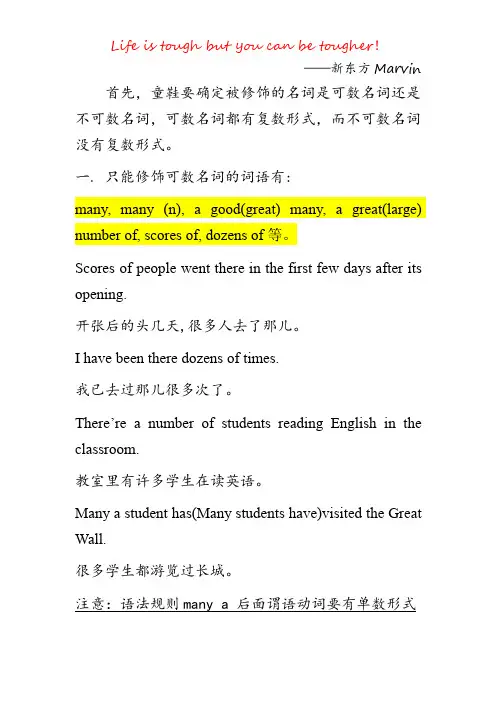
首先,童鞋要确定被修饰的名词是可数名词还是不可数名词,可数名词都有复数形式,而不可数名词没有复数形式。
一.只能修饰可数名词的词语有:many,many(n),a good(great)many,a great(large) number of,scores of,dozens of等。
Scores of people went there in the first few days after its opening.开张后的头几天,很多人去了那儿。
I have been there dozens of times.我已去过那儿很多次了。
There’re a number of students reading English in the classroom.教室里有许多学生在读英语。
Many a student has(Many students have)visited the Great Wall.很多学生都游览过长城。
注意:语法规则many a后面谓语动词要有单数形式In winter,a good many animals sleep under the snow.冬天很多动物在雪下冬眠。
A great number of the graduates have found jobs.毕业生中很多人已经找到了工作。
Dozens of students are playing basketball on the ground.二.只能修饰不可数名词的词语有:much,a great deal of,a great(large)amount of等。
Is there much water in the bucket?桶里有很多水吗?He always has a great amount of work to do.他总是有很多工作要做。
三.既能修饰可数名词又能修饰不可数名词的词语有:a lot of,lots of,plenty of(以上三个词语后谓语动词的数依of后的名词的单复数而定),a great(large)quantity of(其后谓语用单数) quantities of(其后谓语用复数)There is still lots of snow in the garden.花园里还有许多雪。

名词知识讲解什么词可以修饰可数什么可以修饰不可数名词1.some和any的用法:(1)两者修饰可数单数名词,表某一个;任何一个,任何;修饰可数复数名词和不可数名词,表一些;一些,任何。
〔2)一般的用法:some用于肯定句;any用于疑问句,否定句或条件句。
I am looking for some matches.Do you have any matches? I do not have any matches.(3)特殊的用法:(A) 在期望对方肯定的回答时,问句也用some。
Will you lend me some money? (=Please lend me some money.)(B) any表任何或任何一个时,也可用于肯定句,此时只能接可数名词单数。
Come any day you like.(4)some和any后没有名词时,当做代名词,此外两者也可做副词。
Some of them are my students.〔代名词)Is your mother any better?(副词)2. many和much的用法:(1)many修饰复数可数名词,表许多;much修饰不可数名词,表量或程度,意思:许多;大量的;很大程度的。
He has many friends, but few true ones.There hasn't been much good weather recently.(2)many a:many a和many同义,但语气比较强,并且要与单数名词及单数形动词连用。
Many a prisoner has been set free. (=Many prisoners have been set free.)(3)as many和so many均等于the same number of。
前有as, like时, 只用so many。
These are not all the books I have. These are as many more upstairs.They worked like so many ants.(4)as much等于the same amount of, 表同量和同一事情。
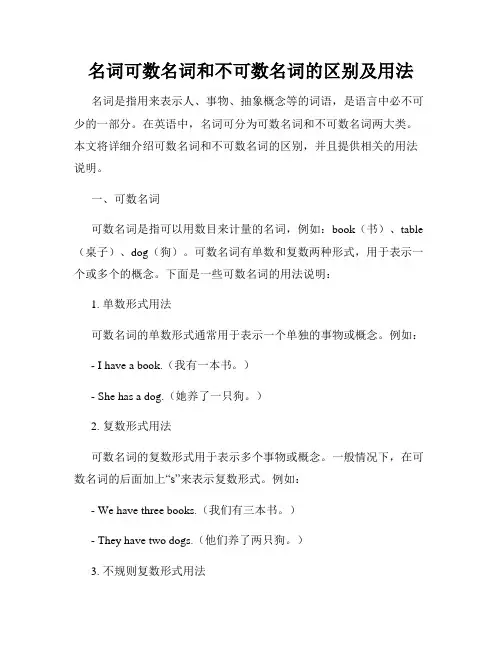
名词可数名词和不可数名词的区别及用法名词是指用来表示人、事物、抽象概念等的词语,是语言中必不可少的一部分。
在英语中,名词可分为可数名词和不可数名词两大类。
本文将详细介绍可数名词和不可数名词的区别,并且提供相关的用法说明。
一、可数名词可数名词是指可以用数目来计量的名词,例如:book(书)、table (桌子)、dog(狗)。
可数名词有单数和复数两种形式,用于表示一个或多个的概念。
下面是一些可数名词的用法说明:1. 单数形式用法可数名词的单数形式通常用于表示一个单独的事物或概念。
例如:- I have a book.(我有一本书。
)- She has a dog.(她养了一只狗。
)2. 复数形式用法可数名词的复数形式用于表示多个事物或概念。
一般情况下,在可数名词的后面加上“s”来表示复数形式。
例如:- We have three books.(我们有三本书。
)- They have two dogs.(他们养了两只狗。
)3. 不规则复数形式用法有些可数名词的复数形式并不是简单地在词尾加上“s”,而是需要根据词汇规则进行变换。
例如:- child(孩子)→ children(孩子们)- tooth(牙齿)→ teeth(牙齿)二、不可数名词不可数名词是指无法用数目来计量的名词,例如:water(水)、milk(牛奶)、information(信息)。
不可数名词没有复数形式,无法表示复数的概念。
下面是一些不可数名词的用法说明:1. 无法数计的用法不可数名词无法用数目来计量,因此不能使用表示数量的词语(如one、two等)来修饰。
例如:- I need some water.(我需要一些水。
)- He gave me a lot of advice.(他给了我许多建议。
)2. 使用量词的用法为了表示不可数名词的数量,我们可以使用一些量词来修饰不可数名词。
例如:- a bottle of water(一瓶水)- a cup of tea(一杯茶)- a piece of information(一条信息)3. 不可数名词作主语和宾语不可数名词可以作为句子的主语或宾语。
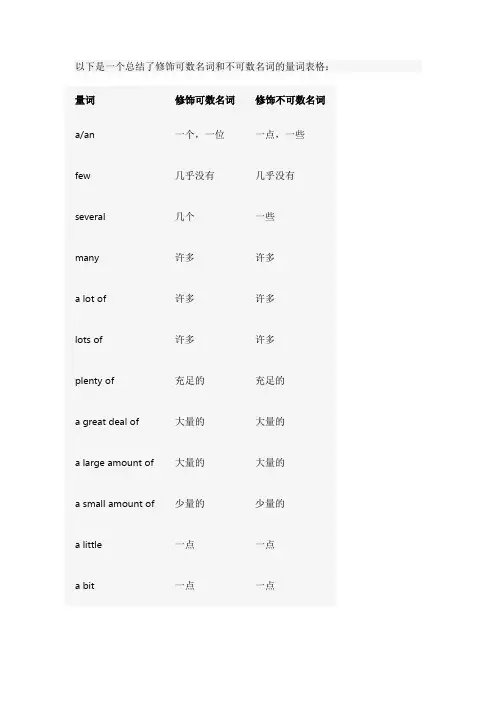
以下是一个总结了修饰可数名词和不可数名词的量词表格:量词修饰可数名词修饰不可数名词a/an 一个,一位一点,一些
few 几乎没有几乎没有several 几个一些
many 许多许多
a lot of 许多许多
lots of 许多许多
plenty of 充足的充足的
a great deal of 大量的大量的
a large amount of 大量的大量的
a small amount of 少量的少量的
a little 一点一点
a bit 一点一点
量词修饰可数名词修饰不可数名词
a great number of 大量的大量的
a good many of 许多的许多的
需要注意的是,有些量词既可以修饰可数名词,也可以修饰不可数名词,如"a lot of"、"lots of"、"plenty of" 等,但它们的意思和用法可能会有所不同。
在使用时,需要根据具体情况进行选择。
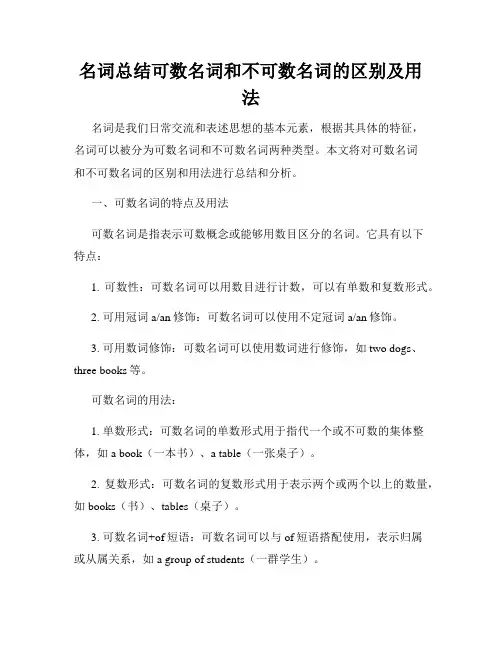
名词总结可数名词和不可数名词的区别及用法名词是我们日常交流和表述思想的基本元素,根据其具体的特征,名词可以被分为可数名词和不可数名词两种类型。
本文将对可数名词和不可数名词的区别和用法进行总结和分析。
一、可数名词的特点及用法可数名词是指表示可数概念或能够用数目区分的名词。
它具有以下特点:1. 可数性:可数名词可以用数目进行计数,可以有单数和复数形式。
2. 可用冠词a/an修饰:可数名词可以使用不定冠词a/an修饰。
3. 可用数词修饰:可数名词可以使用数词进行修饰,如two dogs、three books等。
可数名词的用法:1. 单数形式:可数名词的单数形式用于指代一个或不可数的集体整体,如a book(一本书)、a table(一张桌子)。
2. 复数形式:可数名词的复数形式用于表示两个或两个以上的数量,如books(书)、tables(桌子)。
3. 可数名词+of短语:可数名词可以与of短语搭配使用,表示归属或从属关系,如a group of students(一群学生)。
二、不可数名词的特点及用法不可数名词是指表示不可数概念或不能用数目进行计数的名词。
它具有以下特点:1. 不可数性:不可数名词不能用数目进行计数,只有单数形式。
2. 不可用冠词a/an修饰:不可数名词不能使用不定冠词a/an修饰。
3. 不可用数词修饰:不可数名词不能使用数词进行修饰。
不可数名词的用法:1. 单数形式:不可数名词只有单数形式,如water(水)、information(信息)。
2. 不可数名词+of短语:不可数名词可以与of短语搭配使用,表示归属或从属关系,如a cup of coffee(一杯咖啡)。
3. 不可数名词+量词:不可数名词可以与量词连用,表示数量或程度,如a bottle of milk(一瓶牛奶)、a lot of money(很多钱)。
三、可数名词和不可数名词的区别1. 计数方式:可数名词可以进行数目计数,而不可数名词无法进行数目计数。
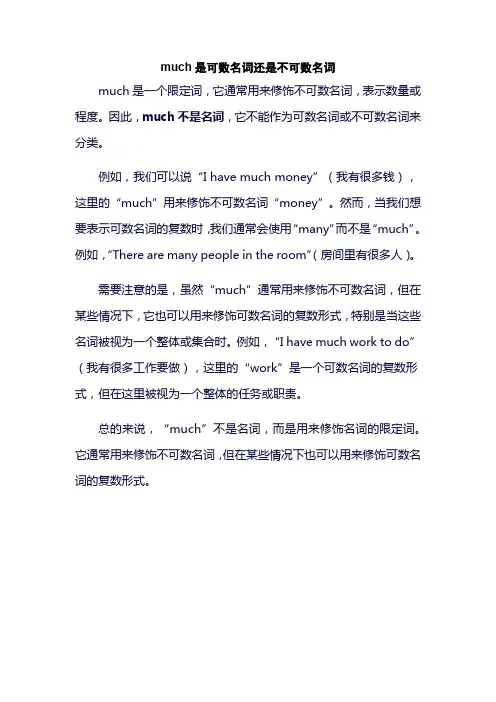
much是可数名词还是不可数名词
much是一个限定词,它通常用来修饰不可数名词,表示数量或程度。
因此,much不是名词,它不能作为可数名词或不可数名词来分类。
例如,我们可以说“I have much money”(我有很多钱),这里的“much”用来修饰不可数名词“money”。
然而,当我们想要表示可数名词的复数时,我们通常会使用“many”而不是“much”。
例如,“There are many people in the room”(房间里有很多人)。
需要注意的是,虽然“much”通常用来修饰不可数名词,但在某些情况下,它也可以用来修饰可数名词的复数形式,特别是当这些名词被视为一个整体或集合时。
例如,“I have much work to do”(我有很多工作要做),这里的“work”是一个可数名词的复数形式,但在这里被视为一个整体的任务或职责。
总的来说,“much”不是名词,而是用来修饰名词的限定词。
它通常用来修饰不可数名词,但在某些情况下也可以用来修饰可数名词的复数形式。

既能修饰可数名词又能修饰不可数名词的词语有:a lot of,lots of,plenty of (以上三个词语后谓语动词的数依of 后的名词的单复数而定),a great / large quantity of (其后谓语用单数),quantities of (其后谓语用复数)。
例如:There is still lots of snow in the garden。
花园里还有许多雪.There is plenty of rain here.这儿的雨水很多.A great quantity of flowers was placed in the hall.大厅里放了很多鲜花。
There are large quantities of food in the cupboard.橱柜里有许多食物。
在所有这些表示“很多”的词语中many, much 是最常用的词,它们既可以用于肯定句,也可以用于疑问句和否定句.例如:Are there many people in the street?街上有很多人吗?There isn't much time left.剩下的时间不多了.其它的词语都用于肯定句,日常会话中常用lots of, a lot of 或plenty of; 正式文体中常用a great many,a (large) number of, a great deal of, scores of 或dozens of 等。
但若肯定句中有too,so,as,very或how 等词修饰时,则必须使用many,much。
例如:The number of the people who lost their homes reached as many as 250,000。
无家可归的人数多达250,000人。
There is too much work to do。
要做的工作太多了.。
可数名词与不可数名词的区别与用法名词作为语言中的一类词性,在句子中起到命名事物的作用。
根据其性质,名词可以分为可数名词和不可数名词。
本文将就可数名词与不可数名词的区别以及用法进行探讨。
一、可数名词可数名词是指可以用数目来计算的名词。
它们可以用于单数和复数形式,并且可以搭配冠词(或其他限定词)进行修饰。
1. 可数名词的单数形式可数名词的单数形式与一件事物相关联,表示单个的实体。
例如:dog(狗)、apple(苹果)。
单数形式的可数名词可以用于句子中作为主语、宾语、定语等。
例如:- 主语:A dog is playing in the park.(一只狗正在公园里玩耍。
)- 宾语:She bought a new dress.(她买了一条新裙子。
)- 定语:We saw a beautiful sunset.(我们看到了一次美丽的日落。
)2. 可数名词的复数形式可数名词的复数形式表示多个实体,用于句子中时通常配合冠词“the”、数量词、代词等使用。
例如:- 冠词“the”:The dogs are barking.(那些狗在叫。
)- 数量词:Three apples fell from the tree.(树上掉下了三个苹果。
)- 代词:I have two books. Can I borrow one of yours?(我有两本书,我可以借你的一本吗?)可数名词的复数形式的使用要注意搭配冠词和形容词的变化。
例如:- 冠词“the”:The students are studying hard.(学生们正在努力学习。
)- 形容词的变化:Those beautiful flowers are in full bloom.(那些美丽的花正盛开。
)二、不可数名词不可数名词是指无法用数目来计算的名词,表示抽象概念、整体、物质等。
它们通常只有单数形式,不能与冠词“a/an”连用,并且不能直接用于复数形式。
little和a little修饰不可数名词few和a few修饰可数名词littl和few 强调少几乎没有。
a little和a few强调有一些。
(a) few + 可数名词, (a) little + 不可数名词a few / a little 为肯定含义,还有一点few / little 为否定含义,没有多少了。
He has a few friends. 他有几个朋友。
He has few friends. 他几乎没有朋友。
We still have a little time. 我们还有点时间。
There is little time left.几乎没剩下什么时间了。
典型例题: Although he 's wealthy,he spends___ on clothes. A. little B. few C. a little D. a few 答案:A. spend所指的是钱,不可数,只能用little或a little. 本句为although引导的让步状语从句,由句意知后句为否定含义,因此应用little表示几乎不。
固定搭配: only a few (=few) not a few (=many) quite a few (=many) many a (=many) Many books were sold. Many a book was sold. 卖出了许多书。
学习好资料欢迎下载
1. 后面+ 单可名
many a + 单可名,谓语动词用单数
2. 后面+ 可数名词复数
a number of ,谓语动词用复数
a large number of
a great number of
a good many, a great many 后面的名词不带限定词,谓语动词用复数
a good many of,a great many of 后面的名词带限定词(限定词是指冠词,指示代词,形容词性物主代词,名词所有格,数词)(冠指物主所有数)(这种区别相当于many/all/most students, many/all/most of the students 的区别)
many
a few, few,谓语动词用复数
3. 后面+不可数名词
a good deal of
a great deal of
a large amount of,谓语动词用单数
a great amount of,谓语动词用单数
amounts of,谓语动词用复数
much,谓语动词用单数
a little,little,谓语动词用单数
a bit of,谓语动词用单数
4. 后面+可数或不可数名词
a lot of, lots of,谓语动词取决于后面的名词是可名复,还是不可名。
plenty of,谓语动词取决于后面的名词是可名复,还是不可名。
a large quantity of, a great quantity of 后面谓语动词用单数
quantities of 后面谓语动词用复数。
some和any的区别及用法例句some常用在肯定句中,而any则常用在否定句和疑问句中。
当表示建议、请求的疑问句,希望得到对方肯定答复时用some而不用any。
当any表示任何的意思,在句子中起强调作用时,也可以用在肯定句中。
some和any既可以修饰名词,可数名词,又可以修饰不可数名词。
一、意思不同1、some:(与不可数名词或复数可数名词连用)一些,若干。
2、any:任何的,任一的,(与单数可数名词连用)任一,非一般的,不寻常的。
二、用法不同1、some:some用作代词的意思是“一些,若干”,指某些特定的或未知的人、物或事,也可表示“有些,其中的一部分”,常用于肯定句中。
some作代词用作主语时,谓语动词的数应依其所代替的名词的单复数形式而定。
2、any:any用作代词的意思是“无论哪个,无论哪些”,主要用说明某一特定类型中的各人或对某一集体中的各个成员或对某事物的各个部分。
any也可用在肯定句中,表示“任何事物”或“任何人”,常用于“anyof...”结构。
三、侧重点不同1、some:一般用在肯定句中,修饰可数或不可数名词。
2、any:一般用在疑问句或否定句中,修饰可数名词。
some,一些,某些,某个.可代替名词和形容词.常用于肯定句.在句子中用作主语、宾语、定语.作定语时,它可以修饰单数可数名词和复数可数名词,也可以修饰不可数名词.1.用于肯定句Ask some boys to help you.(修饰复数可数名词)叫些男孩来帮助你.Please bring some coffee.(修饰不可数名词)请拿些咖啡来.Ask some girl to come here.(修饰单数可数名词)叫(某)个女孩来这儿.2.some用于疑问句时,表示“请求、邀请或希望得到肯定的回答”.Would you like some coffee?(表示请求、邀请)请喝咖啡.Have you some stamps?(希望得到肯定的回答)你有邮票吧?any 一些,任何.可代替名词和形容词.常用于否定句或疑问句,也可以用于条件状语从句.作定语时,它可以修饰复数形式的可数名词和不可数名词.1.用于疑问句或否定句Are there any cows in the fields?(修饰复数形式的可数名词)田里有一些牛吗?There won't be any trouble.(修饰不可数名词)没有任何麻烦.2.用于条件状语从句If there is any trouble, let me know.如果有什么麻烦,要让我知道.3.any用于肯定句时,通常要重读,修饰单数可数名词和不可数名词.Any time you want me, just send for me.什么时候你需要我,随时叫我来.Come any day you like.只要你喜欢,随时可以来.感谢您的阅读,祝您生活愉快。
修饰不可数和可数名词
1 / 4
知识讲解 什么可以修饰可数名词 什么可以修饰不可数名词
一、some和any的用法:
(1)两者修饰可数复数名词和不可数名词,表一些;有些。
〔2)一般的用法:some用于肯定句;any用于疑问句,否定句或条件句。
I am looking for some matches.
Do you have any matches? I do not have any matches.
(3)特殊的用法:
(A) 在期望对方肯定的回答时,问句也用some。
Will you lend me some money? (=Please lend me some money.)
(B) any表任何或任何一个时,也可用于肯定句。
Come any day you like.
二、 many和much的用法:
(1)many修饰复数可数名词,表许多; much修饰不可数名词,表量或程度。
He has many friends, but few true ones.
There hasn't been much good weather recently.
(2)many a:
many a和many同义,但语气比较强,并且要与单数名词及单数形动词连用。
Many a prisoner has been set free. (=Many prisoners ha
ve been set free.)
三. (a) few和(a) little的用法:
(1) (a) few用在复数可数名词之前,(a) little用在不可数名词之前。
He took a few biscuits. (=several) He took few biscuits(=no
t many)
He took a little butter. (=some) He took little
修饰不可数和可数名词
2 / 4
butter. (=not much)
(2) a few相当于some, several, 含肯定的意味。
He has a few (=some or several) friends.
(4) a little和little之间的差别,就和a few和few的差别一样,只
是(a) little须修饰不可数名词,表量或程度。
He grows worse; there is little hope of his recovery.
He is not much better, but there is a little hope.
5. 其他的数量形容词:
(1) plenty of, a lot of, lots of均表许多,修饰复数可数名词或不
可数名词。
The room contained plenty of (or a lot of or lots of) stu
dents.(复数名词)
The room contained plenty of (or a lot of or lots of) furnit
ure.(不可数名词)
(2) a great (or a good) deal of, a large (or a small) quanti
ty of, a large (or a small) amount of, 均表(量), 修饰不
可数名词。
The room contained a great deal of furniture. (不可数名词)
The room contained a good deal of furniture. (不可数名词)
The room contained a large quantity of furniture. (不
可数名词)
The room contained a large amount of furniture. (不可
数名词)
The room contained a small quantity of furniture. (不可
修饰不可数和可数名词
3 / 4
数名词)
The room contained a small amount of furniture. (不可数名
词)
(3) a number of “许多;一些”;a great (large, good) number of
“许多”,修饰复数可数名词,并且要与复数动词连用。
A number of books are missing from the library.
The room contained a great (or large or good) number of
students. (复数可数名词)
the number of +复数名词,其后谓语动词用单数
The number of books from the library is large.
(4) enough的用法:
(A) 可接复数可数名词和不可数名词。
There are enough chairs. (可数)
There is enough furniture. (不可数)
(B) 可放在年修饰名词的前后。
We don't have enough time. =We don't have time enoug
h.
(5) hundreds of, dozens of, thousands of, scores of +复数可
数名词
冠词或数词(one, two...) + (hundred, dozen, thousand, scor
e) 复数可数名词
(6) the rest of “其余的”, 可接复数可数名词及不可数名词,作主
词时,接可数名词则用复数动词,接不可数名词则用单数动词。
The rest of the students are absent. (复数可数名词)
修饰不可数和可数名词
4 / 4
The rest of the water was thrown away. 不可数名词)